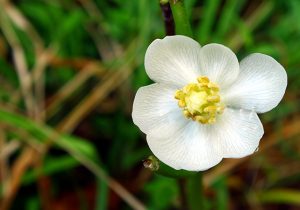
Mayapple – sources, health benefits, nutrients, uses and constituents at NaturalPedia.com
Thursday, August 24, 2017 by Frances Bloomfield
http://www.naturalpedia.com/mayapple-sources-health-benefits-nutrients-uses-and-constituents-at-naturalpedia-com.html

The mayapple (Podophyllum peltatum), also known as American mandrake or ground lemon, is an herbaceous perennial plant native to the woodlands of the eastern United States and southeastern Canada. Nearly all parts of the mayapple are poisonous save for the fruit: once it has turned yellow, the mayapple fruit is safe for human consumption. While not edible, mayapple rhizomes are used for all sorts of medicinal applications. Native Americans valued the rhizome as a cathartic, antihelmintic, and emetic agent.
List of known nutrients
According to TipDisease.com, mayapple is known to contain important constituents such as quercetin, kaempferol, podophyllin, isorhamnetin, gallic acid, berberine, and alpha-peltatin. All of these naturally-occurring compounds possess health-promoting effects that have made the plant highly effective and prized as an alternative medicine.
Berberine, for example, is believed to combat gastrointestinal infections and diseases, and has been used to do so for the longest time. Coincidentally, one of the most common homeopathic uses for mayapple is as a remedy for conditions relating to the digestive tract system.
Medicinal uses for mayapple
Maypple is a gastrointestinal irritant and stimulant, meaning it can increase the activity of the intestines to push out unwanted substances much faster. This goes in-line with one of its most frequent uses in Native American medicine, which is to induce vomiting and expel toxins from the body. In modern terms, this allows mayapple to serve as a treatment for constipation, stomach flu, and even intestinal parasites.
One other frequent homeopathic use for mayapple is as a treatment for excessive bile secretion. Biliousness and jaundice are two health conditions associated with the excess of bile, so mayapple can greatly reduce the symptoms of both. Moreover, the diuretic quality of mayapple can decrease the frequency of gallstones and make it easier for them to pass through the body.
The antiviral quality of mayapple is sometimes utilized to topically treat genital warts.
Body systems supported by mayapple
When utilized in moderate amounts, mayapple can be beneficial to the digestive system, liver, bowels, and skin. The mayapple is a very powerful irritant and stimulant whose effects include that as a laxative, purgative, cathartic, and antibilious agent.
Ways to use mayapple
A tincture can be created from mayapple root. Creating mayapple root tincture involves cutting the rhizome into fine pieces then pounding them in alcohol. The solution is filtered and diluted to decrease its potency. This tincture can then be applied to affected skin areas in small doses, preferably by a qualified practitioner.
Beyond medicinal use, mayapples can have culinary ones too. The aromatic, sweet fruits can either be eaten raw or cooked and made into jams, marmalade, punch, jellies, and pies. Annie Stewart of Grit.com put together a mayapple jelly recipe that yields four small servings.
Green Deane of EatTheWeeds.com, meanwhile, suggests incorporating mayapple fruit into trail mixes, sauces, and cold drinks. Deane and Stewart both stress that the seeds and rinds should never be included in dishes due to their poisonous nature, so be sure to remove these before attempting to cook with mayapple.
Keep in mind that almost all parts of the mayapple plant are toxic and unsafe for consumption. Even ripened mayapple pulp may cause vomiting if eaten in excess, while cases of poisoning have been reported from topical mayapple applications. Exercise the utmost caution when using or eating the root or fruit of this plant, or leave it to be used by individuals with an extensive knowledge of herbal medicine.
Where to learn more
Summary
Mayapple can benefit those who are struggling with certain gastrointestinal, liver, and skin issues.
This plant can be dangerous in the hands of those who have never used it for medicine or for cooking, however.
Save for the ripe fruits, all parts of mayapple are highly dangerous and can be fatal even in small doses. Take extra care with this plant.
Sources include:
FruitsInfo.com
TipDisease.com
Herbs2000.com
AnniesRemedy.com
Grit.com
EatTheWeeds.com
Tagged Under: Tags: Mayapple






